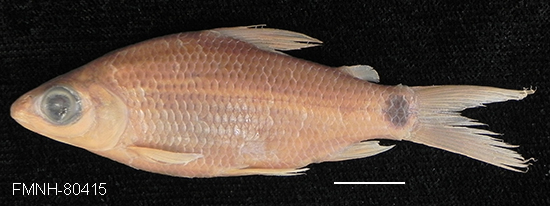| SOURCE FOR OCCURRENCE IN ECUADOR: Vari (1989), Barriga (2012), Jimenez et al. (2015). |
| ORIGINAL DESCRIPTION: Boulenger, G. A. 1911. Descriptions of three new characinid fishes from south-western Colombia. Annals and Magazine of Natural History (Series 8) v. 7 (no. 38):212-213. |
| TYPE SPECIMENS: British Museum of Natural History (Lectotype: BMNH 1910.7.11:159; Paralectotypes: BMNH 1910.7.11:160-162 (Vari, 1989)) |
| TAXONOMIC STATUS: Valid (Eschmeyer and Fricke, 2016). |
| RANGE ECUADOR: Santiago and Cayapas rivers in Esmeraldas province in northwestern Ecuador (Vari, 1989; Jimenez et al., 2015). |
| RANGE OUTSIDE OF ECUADOR: Rio San Juan, Rio Dagua and upper portions of Rio Atrato in Colombia (Vari, 1989). It is worth noting that this is the only species of the genus Pseudocurimata inhabiting rivers draining both into the Pacific and Caribbean (Vari, 1989). |
| COLLECTIONS IN ECUADOR: |
| MAXIMUM SIZE: 114 mm SL, common to 75 mm (Jimenez et al., 2015). |
| DISTINGUISHING FEATURES: The possession of distinct dark spots in longitudinal series on the lateral and dorsal surfaces of the body, a discrete round large dark spot on the caudal peduncle, and having 31-33 vertebrae distinguishes it from all other species in the genus except P. patiae and P. boehlkei (Vari, 1989). Pseodocurimata lineopunctata can be distinguished from P. patiae by having 33-41 lateral line scales compared to 42-47 in the latter. Pseodocurimata lineopunctata can be distinguished from P. boehlkei by having a distinct large round spot on the caudal peduncle compared to a horizontally elongated dark band on the caudal peduncle in the latter (Vari, 1989). |
| ECOLOGY: Known as dica in Ecuador, this species is typically found in the low altitude portions of streams where aquatic vegetation is present and water depth can be characterized as shallow. It feeds on detritus (Jimenez et al., 2015). |
| ECONOMIC IMPORTANCE: Not of economic importance due to its small size although it is consumed by people when caught (Jimenez et al., 2015). |
| CONSERVATION STATUS: Little is known about its current status although it does not appear to be very common and occurs in areas that are threatened by mining contamination (Jimenez et al., 2015). |
| LINK TO FISHBASE PAGE: Click here for link |
| SPECIES PROFILE CREATED BY: Windsor Aguirre |
| SPECIES PROFILE CONTRIBUTORS: NA |
